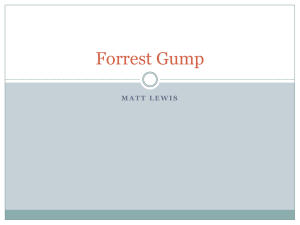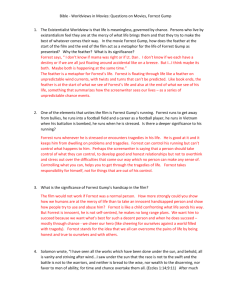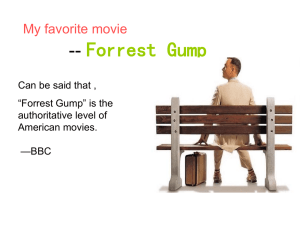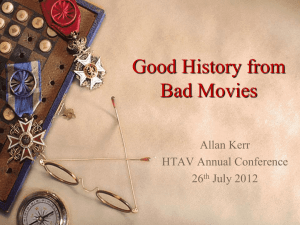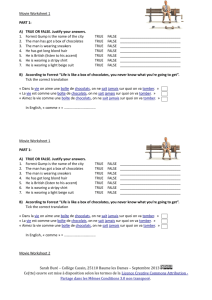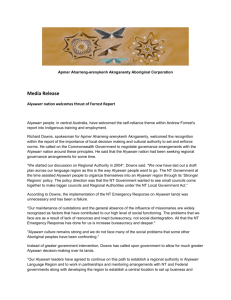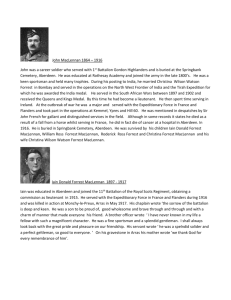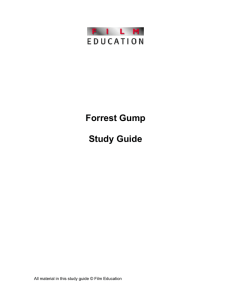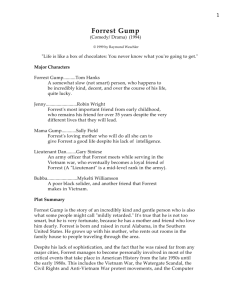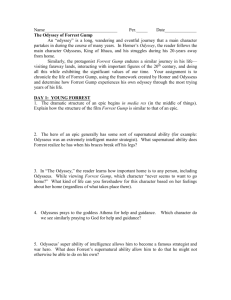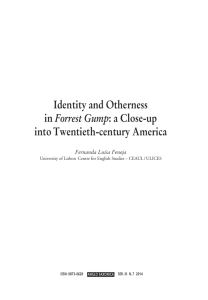US History Study Guide social movements
advertisement
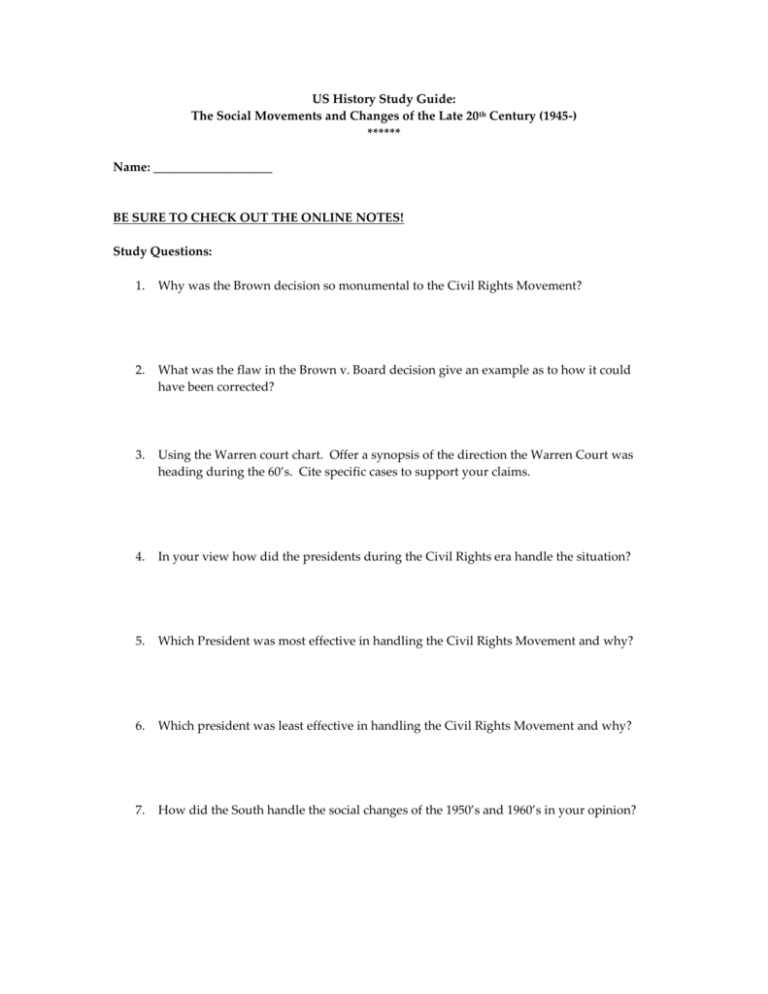
US History Study Guide: The Social Movements and Changes of the Late 20 th Century (1945-) ****** Name: ___________________ BE SURE TO CHECK OUT THE ONLINE NOTES! Study Questions: 1. Why was the Brown decision so monumental to the Civil Rights Movement? 2. What was the flaw in the Brown v. Board decision give an example as to how it could have been corrected? 3. Using the Warren court chart. Offer a synopsis of the direction the Warren Court was heading during the 60’s. Cite specific cases to support your claims. 4. In your view how did the presidents during the Civil Rights era handle the situation? 5. Which President was most effective in handling the Civil Rights Movement and why? 6. Which president was least effective in handling the Civil Rights Movement and why? 7. How did the South handle the social changes of the 1950’s and 1960’s in your opinion? 8. Describe Martin Luther King’s approach to social movements. Was it effective? 9. Describe Huey Newton and Bobby Seale’s approach to social movements. Was it effective? 10. How did the social movements of Hispanic-Americans, Native Americans, and women mirror the African American Experience? 11. Assess the presidency of Lyndon B. Johnson. 12. What did you think of the Black Panther political platform? What would mainstream America have thought of these ideas? 13. What was Nixon’s approach to Civil Rights? 14. The 1970’s are viewed by many as a cultural void…what differences exist between the cultural rich 1960’s and the 1970’s? 15. What changes do you see America facing as we begin our new millennium? 16. Using the reading attached…what were the causes behind the situation in 1963? 17. Why was 1963 in Washington such a powerful time and place? 18. Using the chart on voting rights…what changes did the 24th amendment bring to the situation of the south? 19. What political ramifications emerged from the voting changes of African Americans? 20. What social problems plagued the 1980’s? Were they effectively dealt with from where you sit in 2002? Forrest Gump: Making Associations in History Mr. Hermansen-US History The film Forrest Gump, is a brilliant film loaded with historical and psychological metaphors that are beautifully interwoven into a great story. The film does a tremendous job of presenting each historical period of the United States during the cold war period. The film magnificently tells the story of the 50’s-80’s through the eyes of a pure-innocent observer and the cast of characters he meets on his journeys through his own life. Forrest is unique in that he is an individual without bias, and he seems to flow through history as a blank slate…he seems to absorb all of his events and experiences with out bias or prejudice allowing those around him to illustrate these traits. Here are some examples of how the movie represents the different stages of US History: 1950’s: Forrest grows up in a pristine southern environment. He never knows his father who takes a “vacation” yet, despite the absence of a role model in his life Forrest is able to transcend that and represent the innocent pristine virtues displayed by America during the 1950’s. Forrest meets the ultimate example of innocence and virtue Jenny a young girl so sweet and innocent that she refuses to be corrupted by her volatile surrounding. Appropriately enough her pristine, virtue lasts only as long as Americas does-the next decade. Issues of popular culture and civil rights are raised, particularly through the eyes of Forrest who experiences his own civil rights journey as he is chastised for his educational differences. 1960’s: The transition of Jenny is telling to the understanding of the 1960’s. Like the kids of her generation, Jenny seeking outlets for her regressed emotions is led to the counterculture movement of the mid-late 1960’s. She like many kids of her generation had held in feelings behind the veil of the tranquil 50’s and those feelings of regression explode in anger at the Vietnam War and the Civil Rights Movement. Forrest goes to college, as many of his generation does really without purpose, the fact that Forrest takes “Home Ec” courses in college and professes no field of study is a representation of how many viewed academics during the time period-as an escape to Vietnam. However, unlike most of his peers Forrest volunteers for Vietnam! It is here that the second of the great civil rights statements are made (Vivian Malone’s book and the “Coon” exchange being the first) it is the exchange and friendship between Forrest and Bubba. The friendship develops as two “outcasts” find each other a cognitively challenged individual and the rural African-America, Bubba. The friendship is forged out of their loneliness and is developed through the film into the most sacred of relationships. The actions speak volumes about Civil Rights, in this case oddly being unified and solidified by Vietnam! Vietnam is obviously represented from both a military and social perspective. The military includes Lt. Dan and the brigade and their instructions/adventures in the Jungles of Vietnam. (Music is telling here) The social includes the unrest Forrest finds upon returning home with his “Million Dollar Wound”, he is immediately thrust into a situation where he is treated ambivalently by his surroundings and only finds peace when he reaches to the past with Jenny. However, this peace proves to be short lived, as the essence of that peace is damaged and impure as tales of the counterculture are revealed and Jenny is threatened by her current existence. The world she longed for comes crashing down at the Black Panther Party and her vestige of the 50’s is forced to interact with her counterculture of the 1960’s (her obnoxious boyfriend from Berkeley). This encounter shows in her departure that for they 60’s at this time the 50’s are dead as she chooses to return to her misery as opposed to reaching for the past with Forrest. 1970’s: Forrest begins the late 60’s and early 70’s with a new hobby Ping Pong, interesting how the most simplistic of hobbies/games can serve to unite us as Forrest uses his skill to bring about Ping Pong diplomacy in the 1970’s. Forrest comes home to find a new world a world foretold about by his friend John Lennon who will be assassinated at the dawn of the new decade. This event seems to signal those things to come as Forrest encounters the confusion of the 70’s represented by Lt. Dan’s struggle to come to grips with his own past and future as well as the concurrent, recurring struggles of Jenny which is culminated by her attempt to take her own life. In a gasp to try and recover from the confusion she is in Jenny the icon of the film reaches back to the 50’s and attempts to rekindle the spirit of that decade by her relationship and stay with Forrest. The relationship and the marriage offer signal to Jenny that the ideals of her life those of the 60’s and 70’s could be forever damaged by her acceptance of these vows, in response she flees. Forrest, representing the confused 70’s decides to return to his 50’s as he is affected by the irrationality of the 70’s he decides to run. His run, which was subject to all kinds of interpretation during the film is nothing more than a return to normalcy of the 1950’s, the one thing Forrest truly understood, the simple virtue. 1980’s: The decade dawns as Forrest’s run spans the late 70’s, he returns from his run and later learns that Jenny has sent for him in her major southern city apartment lifestyle-a clear indicator that in a large sense she has embraced the values of her youth and is moving away from confusion and into cohesion with her ideals and her existence. However, a grim specter emerges on the landscape as her wedding looms with Forrest Jenny tell Forrest that she has a disease, a virus that the doctors are helpless against. The virus, although never mentioned by name is HIV + or AIDS. Her contraction of the disease is never explicitly stated however it is obvious watching Jenny experience the counterculture and the drug induced confusion of the 70’s that her past has caught up with her and the mistakes of the past (Heroin abuse and free love movement) seem to forge her future. A stirring reminder to America that the AIDS virus is not a “Gay” disease rather it is a disease that can effect anyone that meets its criteria, one of which is drug abuse and sexual promiscuity. The film ends with Forrest attempting to come to grips with the realization of fatherhood, the loss of Jenny, and the changing times. The loss of Jenny seems to be a metaphor for the death of the ideals of the past and places Forrest at a crossroads. Could it be observed that the crossroads is defined by the feather? Music and symbols: obviously the film has a terrific soundtrack, keep in mind that all of the music tells a story, a historical story told through the metaphors and allegory of the film but also through the music. Case in point: “Fortunate Son” and “Freebird.” Conclusion: keep in mind that this movie operates on many different levels, it is a very deep film, this is the interpretation of one observer and there are bound to be many more. Caveats aside there is little doubt that the film Forrest Gump is a terrific historical allegory that explores the themes of the Baby Boomer generation.
